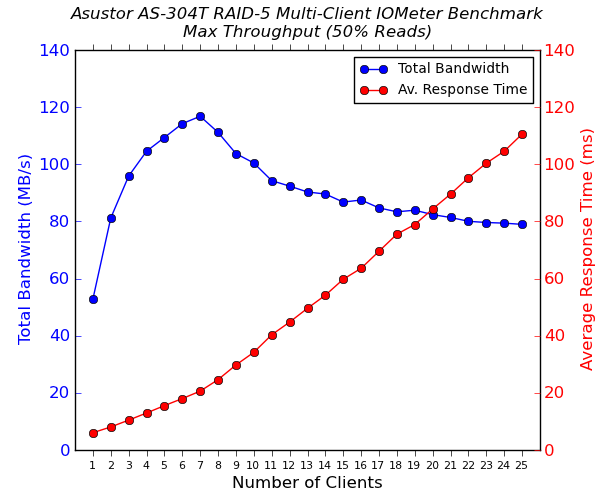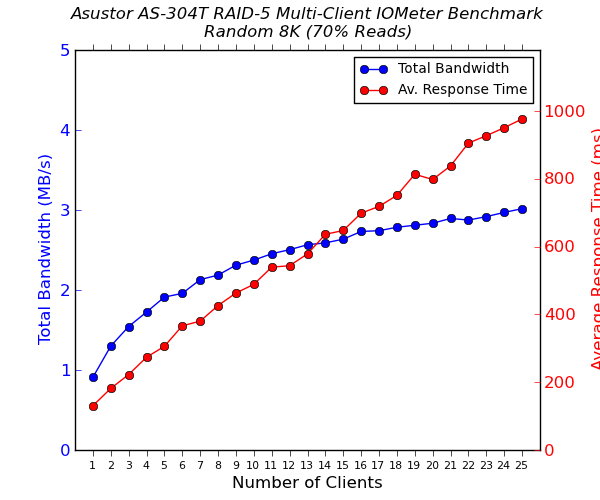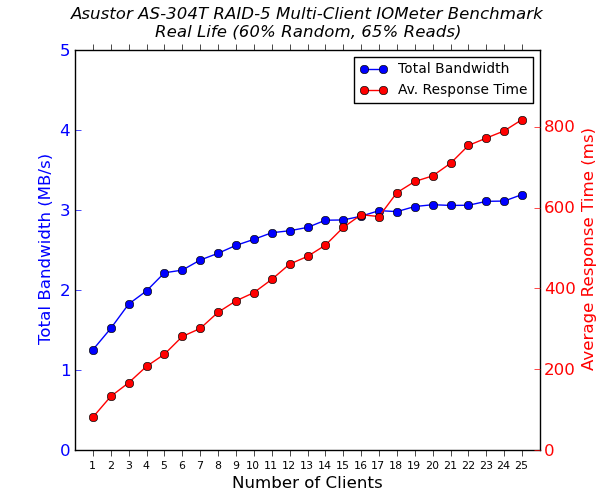Asustor AS-304T: 4-Bay Intel Evansport NAS Review
by Ganesh T S on March 26, 2014 11:15 AM ESTMulti-Client Performance - CIFS
We put the Asustor AS-304T through some IOMeter tests with a CIFS share being accessed from up to 25 VMs simultaneously. The following four graphs show the total available bandwidth and the average response time while being subject to different types of workloads through IOMeter. IOMeter also reports various other metrics of interest such as maximum response time, read and write IOPS, separate read and write bandwidth figures etc. Some of the interesting aspects from our IOMeter benchmarking run can be found here.




The other 4-bay NAS solutions that we have evaluated before all come with two GbE links. This allows for link aggregation, enabling them to perform well in multi-client scenarios. We find that the single network link of the AS-304T acts as a bottleneck. Beyond eight simultaneous CIFS connections, the performance even starts to suffer a bit for certain workloads. That said, the AS-304T does manage to hold its own when it comes to performance consistency in terms of average response times.










34 Comments
View All Comments
bernstein - Wednesday, March 26, 2014 - link
Does this NAS finally have ECC?? (like for instance an ECC enabled ZFS linux fileserver)do people actually know how many digital photos get corrupted in 20years of not using ECC?
protomech - Wednesday, March 26, 2014 - link
No. How many digital photos are corrupted due to lack of ECC?I assume you're talking about ECC on the storage pools, not ECC in the computer main memory..
manmax - Wednesday, March 26, 2014 - link
He mentions ZFS so I guess he means the data integrity checking and self-healing of corrupted data features of ZFS and Btrfs. This is probably my main reason to go with ZFS or Btrfs for NAS devices especially when used for backup purposes.Overtime, bits can just randomly flip on a hard drive (the drive is still perfectly fine). For example, old photos, music and videos all of sudden don't open or are distorted. RAID (at least most implementations I've seen) doesn't save you from random bit flipping. It's mainly for keeping a server up if a drive completely fails, not from file corruption.
Gigaplex - Saturday, March 29, 2014 - link
I've had file system corruption because a stick of RAM went bad, affecting the file system cache. My next build will have ECC RAM.hoboville - Thursday, March 27, 2014 - link
Without ECC, a scrub of a ZFS pool can corrupt your entire dataset. It happens, a lot. Regardless, ZFS provides better features like ARC, and full CoW. Ext4 RAID would be viable too, but for an average home user, ZFS is going to be too much because it has higher hardware requirements, requires a more advanced user, and will generally cost more money. Like Ganesh said, these cheapo units are good for simple HTPC stuff.Oyster - Wednesday, March 26, 2014 - link
Good work, Ganesh. Thanks for incorporating our feedback and including competitor benchmarks as standalone performance graphs.ganeshts - Wednesday, March 26, 2014 - link
Thanks! The suggestion made sense, but we were waiting till we got enough units reviewed with the new methodology in each category (splitting by number of bays)Flunk - Wednesday, March 26, 2014 - link
Is Asustor in any way related to ASUS?ganeshts - Wednesday, March 26, 2014 - link
Yes, they are a subsidiary of AsusDirector12 - Wednesday, March 26, 2014 - link
How does it stack against the Asustor 604T?